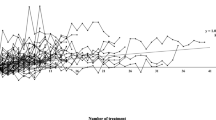Abstract
Purpose
Nedaplatin is a second-generation platinum showing favorable activity against non-small cell lung cancer (NSCLC). Dose-limiting toxicity (DLT) is thrombocytopenia, predicted by creatinine clearance (Ccr). This study was conducted to determine the recommended dose, and evaluate the toxicities, pharmacokinetics and efficacy for elderly NSCLC patients.
Methods
Patients ≥70 years were stratified into two groups based on renal functions: Group A, Ccr ≥ 60 and Group B, 40 ≤ Ccr < 60. The initial doses were 80 and 60 mg/m2 in Groups A and B, respectively. The doses were escalated in 20-mg/m2 increments to 100 mg/m2 until DLT.
Results
Chemotherapy-naïve 39 elderly patients (Group A/Group B: 22/17) received a total of 83 cycles. Major toxicities were hematological. In Group A, one of the 15 patients at 100 mg/m2 experienced DLT (neutropenia) and the recommended dose was determined at 100 mg/m2. In Group B, three of the five patients had DLTs (leukopenia, neutropenia, thrombocytopenia and febrile neutropenia) at 100 mg/m2, and the recommended dose was determined at 80 mg/m2. The percentage decreases of neutrophil were well correlated with total and free-Pt AUCs. Partial responses were observed in 13 (33%) of the 39 patients, and 12 of the 13 patients who responded had a squamous cell carcinoma.
Conclusions
Nedaplatin was administered simply and feasibly by stratifying renal function and exerted favorable antitumor activity for elderly patients with NSCLC, especially on squamous cell carcinoma.


Similar content being viewed by others
References
Kaneko S, Ishikawa KB, Yoshimi I et al (2003) Projection of lung cancer mortality in Japan. Cancer Sci 94:919–923
Schiller JH, Harrington D, Belani CP et al (2002) Comparison of four chemotherapy regimens for advanced non-small cell lung cancer. N Engl J Med 346:92–98
Ohe Y, Ohashi Y, Kubota K et al (2007) Randomized phase III study of cisplatin plus irinotecan versus carboplatin plus paclitaxel, cisplatin plus gemcitabine, and cisplatin plus vinorelbine for advanced non-small cell lung cancer: Four-Arm Cooperative Study in Japan. Ann Oncol 18:317–323
Kubota K, Watanabe K, Kunitoh H et al (2004) Phase III randomized trial of docetaxel plus cisplatin versus vindesine plus cisplatin in patients with stage IV non-small cell lung cancer: the Japanese Taxotere Lung Cancer Study Group. J Clin Oncol 22:254–261
Oshita F, Kurata T, Kasai T et al (1995) Prospective evaluation of the feasibility of cisplatin-based chemotherapy for elderly lung cancer patients with normal organ functions. Jpn J Cancer Res 86:1198–1202
Yamamoto N, Tamura T, Maeda M et al (1995) The influence of ageing on cisplatin pharmacokinetics in lung cancer patients with normal organ function. Cancer Chemother Pharmacol 36:102–106
Kanzawa F, Matsushima Y, Nakano H et al (1988) Antitumor activity of a new platinum compound (glycolate-O,O′) diammineplatinum (II) (254-S), against non-small cell lung carcinoma grown in a human tumor clonogenic assay system. Anticancer Res 8:323–327
Suzumura Y, Kato T, Ueda R et al (1989) Effect of treatment schedule on antitumor activity of glycolate-0, 0′-diammineplatinum(II), a new platinum derivative: comparison with cis-diamminedichloroplatinum(II). Anticancer Res 9:1083–1088
Hida S, Okada K, Yoshida O (1990) Advantages in combination chemotherapy using cisplatin and its analogues for human testicular tumor xenografts. Jpn J Cancer Res 81:425–430
Furuse K, Fukuoka M, Kurita Y et al (1992) A phase II clinical study of cis-diammine glycolato platinum, 254-S, for primary lung cancer. Gan To Kagaku Ryoho 19:879–884
Sasaki Y, Fukuda M, Morita M et al (1990) Prediction from creatinine clearance of thrombocytopenia and recommended dose in patients receiving (glycolato-O,O′)-diammine platinum (II) (NSC 375101D). Jpn J Cancer Res 81:196–200
LeRoy AF, Wehling ML, Sponseller HL et al (1977) Analysis of platinum in biological materials by flameless atomic absorption spectrophotometry. Biochem Med 18:184–191
Yamaoka K, Nakagawa T, Uno T (1978) Application of Akaike’s information criterion (AIC) in the evaluation of linear pharmacokinetic equations. J Pharmacokinet Biopharm 6:165–175
Sasaki Y, Tamura T, Eguchi K et al (1989) Pharmacokinetics of (glycolate-O,O′)-diammine platinum (II), a new platinum derivative, in comparison with cisplatin and carboplatin. Cancer Chemother Pharmacol 23:243–246
The Elderly Lung Cancer Vinorelbine Italian Study Group (1999) Effects of vinorelbine on quality of life and survival of elderly patients with advanced non-small cell lung cancer: The Elderly Lung Cancer Vinorelbine Italian Study Group. J Natl Cancer Inst 91:66–72
Gridelli C, Perrone F, Gallo C et al (2003) Chemotherapy for elderly patients with advanced non-small cell lung cancer: the Multicenter Italian Lung Cancer in the Elderly Study (MILES) phase III randomized trial. J Natl Cancer Inst 95:362–372
Kudoh S, Takeda K, Nakagawa K et al (2006) Phase III study of docetaxel compared with vinorelbine in elderly patients with advanced non-small cell lung cancer: results of the West Japan Thoracic Oncology Group trial (WJTOG 9904). J Clin Oncol 24:3657–3663
Calvert AH, Newell DR, Gumbrell LA et al (1989) Carboplatin dosage: prospective evaluation of a simple formula based on renal function. J Clin Oncol 7:1748–1756
Kato H, Fukuchi M, Manda R et al (2003) Efficacy and toxicity of nedaplatin and 5-FU with radiation treatment for advanced esophageal carcinomas. Anticancer Res 23:3493–3498
Kodaira T, Fuwa N, Tachibana H et al (2006) Phase I study of S-1 and nedaplatin for patients with recurrence of head and neck cancer. Anticancer Res 26:2265–2268
Yoshioka T, Sakayori M, Kato S et al (2006) Dose escalation study of docetaxel and nedaplatin in patients with relapsed or refractory squamous cell carcinoma of the esophagus pretreated using cisplatin, 5-fluorouracil, and radiation. Int J Clin Oncol 11:454–460
Kanai M, Matsumoto S, Nishimura T et al (2007) Retrospective analysis of 27 consecutive patients treated with docetaxel/nedaplatin combination therapy as a second-line regimen for advanced esophageal cancer. Int J Clin Oncol 12:224–227
Acknowledgments
This work was supported by a Grant-in-Aid for Cancer Research (9-25) from the Ministry of Health and Welfare, Tokyo, Japan.
Author information
Authors and Affiliations
Corresponding author
Rights and permissions
About this article
Cite this article
Yamamoto, N., Tamura, T., Kurata, T. et al. A dose-finding and pharmacokinetic study of nedaplatin in elderly patients with advanced non-small cell lung cancer. Cancer Chemother Pharmacol 65, 79–88 (2009). https://doi.org/10.1007/s00280-009-1006-9
Received:
Accepted:
Published:
Issue Date:
DOI: https://doi.org/10.1007/s00280-009-1006-9




